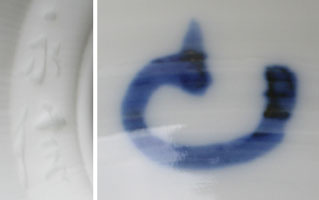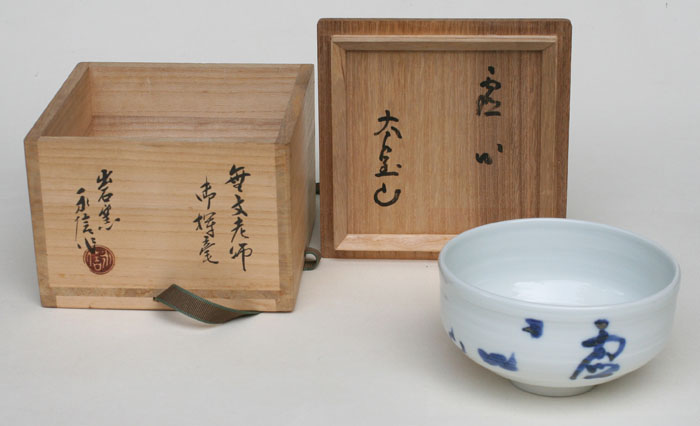Izushiyaki
Chawan, tea bowl - Kyoshin, Lack of prejudiceSigned: kaô [Taishitsu], Eishin
Seals:
Technique: Izushiyaki, white seikaji, porcelain from Izushi, in Hyogo province, with a blue Ø13,5 (12,7) x 7
Box: signed by Mumon
Condition: fine
Mumon (Taishitsu) was born into a wealthy family. His father wanted him to become a lawyer, and it was in law school that was converted to the Buddhist life by a Confucian saying: “Rather than being a lawyer, create a world where there is no need for courts”. After taking the tonsure, he initially studied under Kawaguchi Ekai (1866-1945), the first Japanese Zen priest to visit Tibet. Mumon entered the Tenryû-ji monastery in 1929 and practiced Zen under Seisetsu Genjô (1877-1945) for many years. However after several years in isolation battling tuberculosis, he emerged to receive his certificate of enlightenment from Seisetsu. In 1949, he became the abbot of Reiun-in, which is one of the four main sub-temples of Myôshin-ji. He subsequently became the president of Hanazono College and established the Institute of Zen Culture. He was invited to be the Zen master of Shofuku-ji monastery in Kobe in 1953 and was the chief abbot of Myôshin-ji from 1978 until 1981. During the 1960 he travelled to several Southeast Asian countries to apologise for Japanese behaviour during the Second World War.
Reference:
Moog p. 318
Dujin p. 55-61, 88-89
The ceramics of Nagasawa Kyodai Seito, Nagasawa IV, are highly regarded and can be found on permanent display at the National Museum of Modern Art in Tokyo.
Izushiyaki is white porcelain from Hyôgo made out of Kakitani stone. This type of porcelain was for centuries imported from Korea. However, during the 17th century kaolin was discovered in the Izushi area, resulting in an influx of craftsmen from Arita who helped to start up production. The first kiln was in Hosomi village, Hyôgo.
Price: ON REQUEST

